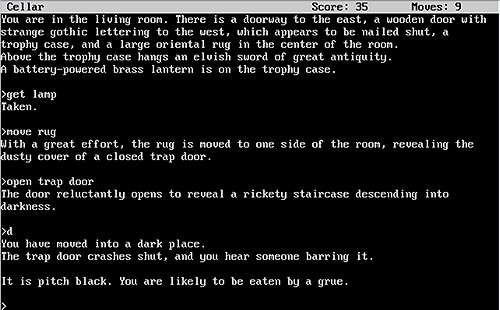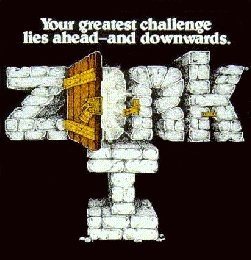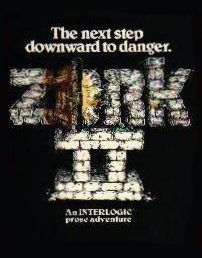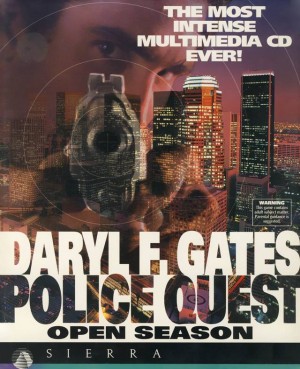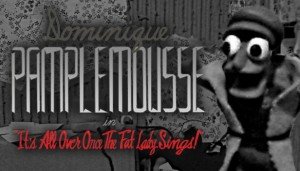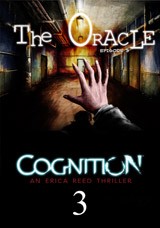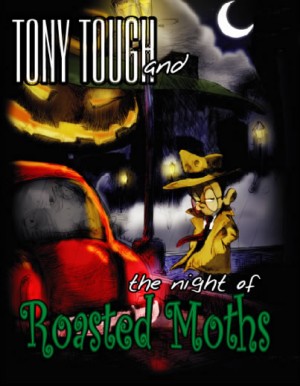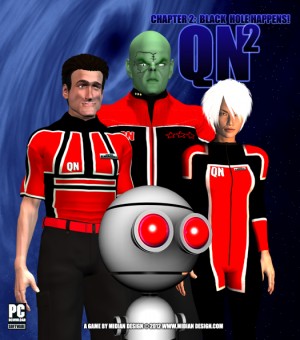GDC 2014 - Zork Post-Mortem page 3

For longtime adventure fans, the lexicon associated with the text adventure Zork and the company founded to publish it, Infocom, have become legend. Many gamers still recoil at the thought of the grues lurking in the dark, fondly recall the arcane magic words necessary to survive in the Great Underground Empire, and laugh about the fallen Flathead empire. Even the term “Implementor” to refer to an Infocom designer has become not only a part of gaming history, but a powerful artifact from the beginning of digital storytelling.
 |
 |
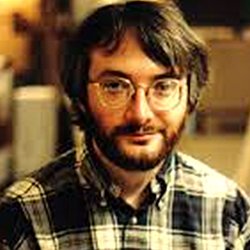 |
 |
From top: Dave Lebling, Mark Blank, Tim Anderson and Bruce Daniels, circa 1980 |
On a Thursday evening in downtown San Francisco, Dave Lebling, one of the founders of Infocom and also one of the original Implementors, hosted a post-mortem to discuss the origins and legacy of 1977’s Zork. Lebling would go on to write and design several more text adventures for Infocom, including classics such as Starcross, Suspect, Spellbreaker, The Lurking Horror and James Clavell’s Shogun. To this day, however, Zork remains the highest-selling and most iconic game that Infocom published and is rightly considered the spiritual godfather of all gaming. What many people aren’t aware of, however, is that Zork is in fact a spiritual successor itself.
As Lebling approached the podium in front of a crowd that included other Infocom luminaries such as Steve Meretzky, Bob Bates, and Michael Dornbrook, as well as text adventure historian and Get Lamp director Jason Scott, he began by asking how many people had ever played a text adventure. Although the response was nearly unanimous, Lebling began by explaining the format and origins of the text adventure (or “interactive fiction,” the term which Infocom would coin and is now the commonly accepted moniker for text-based adventure games). “A text adventure,” Lebling said, “is a game you play entirely by telling the computer what to do and the computer tells you what happens. It’s kind of like playing D&D (Dungeons & Dragons) except with a DM (dungeon master) who is really stupid, but also a DM who is totally without any qualms about killing the player.”
The original designers/Implementors of Zork all met at the Massachusetts Institute of Technology (MIT). In addition to Lebling, the original Zork team included Marc Blank, Bruce Daniels, and Tim Anderson. All would eventually become important players in the establishment of Infocom.
Lebling explained that to understand the beginning of Zork, you had to understand the timeframe when it was created. “The late ‘70s were kind of like today in some ways. While we have Downtown Abbey they had Upstairs, Downstairs. We have 12 Years a Slave, they had Roots. We had Star Wars both times. Star Wars came out during the month we started on Zork.”
In addition to the aesthetic sensibilities of the times, the original Zork team had to deal with the technological limitations of the period, although at the time, MIT’s collection of equipment seemed like a gold mine to the young students. Even the university’s PDP-10, which the group would use to code Zork, and its whopping 2 MB of storage seemed like an embarrassment of riches. In addition, MIT’s mainframes were all networked through the ARPANET, a precursor to today’s Internet, which allowed remote users to access applications through smaller terminals not much different in size than today’s desktop PCs. The ability to access Zork remotely would eventually help to build an original, and dedicated, user group for the game.
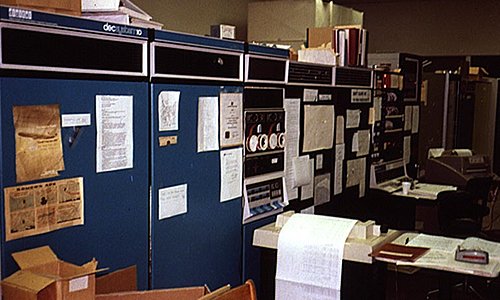 |
The PDP-10 at the Stanford AI lab |
The greatest influence on Zork, however, was the first text adventure game: Will Crowther’s and Don Woods’s aptly named Adventure. Crowther, an avid caver, wrote Adventure in 1976 as a program to share his experiences exploring Kentucky’s Mammoth Cave system with his daughters. A year later, Stanford University graduate student Woods discovered the game and asked Crowther for permission to expand and improve upon the original.
“Adventure was the father of us all,” said Lebling, as he showed a slide of the personal map that he drew for the game’s twisty little passages. “It allowed you to crawl through Colossal Cave in Kentucky. I think the official name of it was the Bedquilt Cave. If you ever manage to go to that cave, people report that it is exactly like that part of the game. All the parts of Adventure that describe caves are real-life descriptions. Don was more of a game type… so he started putting in treasures, enemies, puzzles and magic words, cheering elves and dwarves. It made it more of a fun game.” When Woods released the new version of Adventure on the ARPANET, according to Lebling, “for two weeks, all work stopped.”
 |
Lebling's personal map of Adventure's cave system [click for full image] |
As enjoyable as the game was, Lebling and his colleagues also felt the game, and specifically the parser which the player used to interact with the game world, was fairly primitive. Adventure’s parser could only understand two words at a time and had a rather limited vocabulary.
Stanford and MIT have always been bitter rivals within the scientific and research fields, and Lebling noted that this competition provided even more motivation for him and for his MIT colleagues to outdo Woods’s work in improving the nascent adventure genre.
They did already have experience creating and coding games. They had created a game called Maze which wasn’t unlike a primitive first-person shooter, in which the player navigated a maze while fighting fellow players or computer-controlled robots. They had also designed the classic monster hunting game, Hunt the Wumpus, as well as a crowd-sourced trivia game which brought them a growing audience interested in their work.
Lebling himself wrote the team’s very first attempt at a true text adventure, although it wasn’t until he went on a vacation that Blank, Anderson and Daniels took over and worked on vastly enhancing the parser’s ability to recognize and comprehend textual input. “One of the puzzles involved putting a [toy musical] band in a bandbox, and when you did put the band in the bandbox, it played ‘Hail to the Chief,’ said Lebling. “That was one of the more exciting puzzles – but notice ‘put band in bandbox.’ It had a three word parser!”
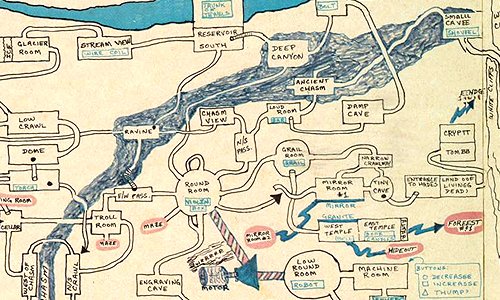 |
An iteration of Zork's dungeon map, January 1981 [click for full image] |
Unfortunately, this original four-room adventure has been lost to history but it allowed the group to believe they were capable of building the better, more advanced adventure they had dreamed of, so they began work on Zork. Lebling showed the original notes from the initial design for the game – which included some of the elements and puzzles the team wanted to include: a troll, a cyclops (a Blank contribution inspired by The 7th Voyage of Sinbad), a reservoir, an echo room, and pit traps. Anderson was “obsessed” with the idea of a thief who would torment the player throughout the journey.
Lebling recounted the story of how Zork’s most famous danger was born. When he returned from his vacation, Lebling began to play through the initial version of the game. In order to require the player to find a light source as an early puzzle, any unlit area would result in the player falling down a pit. As he explored the first iteration of the famous white house, he fell down a pit – in the attic. “I decided there should be monster that could get you in the dark instead,” Lebling explained. “So I invented grues.”
He made no bones that he stole the name of Zork’s famous monster from science fiction/fantasy author Jack Vance (who is no stranger to having his ideas purloined – Gary Gygax based D&D’s magic system on Vance’s Dying Earth series, the same series which introduced predatory grues). During the Q&A session, Lebling was asked what a grue looked like: “If I knew what a grue looked like… well then, that would be an illogical possibility because if I knew what a grue looked like, I would be dead.”
As the team continued to work on Zork the parser also continued to evolve, including being able to understand the difference between putting an object down, placing it under another object, or even placing an object inside of a container. The parser also began to understand the difference between the game’s different actors, from the player’s nameless avatar to a controllable robot and even the vehicles within the game. The team even added a timer to the events within the game world based on the number of moves a player would make. This timer might determine how long a match would stay lit, or which room the thief was currently occupying.
 |
Zork art, IEEE Computer, April 1979 |
The story design of the game, however, didn’t improve as quickly as its technical capabilities. Lebling showed a video where Blank talked about how narrative wasn’t a particular concern during the original process. “When the game was first being written, just like the original Adventure, it had no real story,” Blank said in the video. “There were places to go and things to do but they were not at all tied together. There was no intention to tie it together. It was all different pieces of fun that you could do in any order.”
Lebling believes Blank may be overstating the lack of design in the game, and credited him with coming up with a number of Zork’s more innovative ideas to create interactive challenges and opportunities for the player. Blank proposed the idea of vehicles, including how to use the inflatable boat as a rather clever solution for carrying treasure, and a robot which allowed the player to deliver direct commands. Lebling also pointed to the team's open collaboration as responsible for adding so much content to the initial game. “Every time we turned around, someone came up with a new idea,” he said.
At the same time that Zork was being designed, the team was also beginning to build the foundation for their company, Infocom. They knew that Infocom could be the developer for Zork but they had no idea how to fit this new program, which was only getting bigger with each new puzzle, location, and character, onto the personal computers available at the time. They were writing Zork in the MUDDLE language, and it required over a megabyte of memory to run, while the most popular American computers, such as Tandy’s TRS-80 and the Apple II, only had 32K. The task of writing code for each different computer in a very dynamic and nascent software marketplace was also daunting.
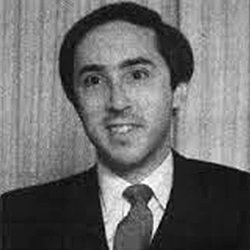 |
Joel Berez |
Lebling showed another video where another one of Infocom’s founders, Joel Berez, came up with a solution based on the work of early computer programmers at the University of California, San Diego.
“I had been playing with UCSD Pascal, which was an implementation that used threaded code where reasonably high level instructions were coded down to 1-2 bytes so that you could have a fairly complex program that actually took up very little space,” Berez said. Also from the video, Blank added, “They invented a language that was portable… It was coming up with machine-independent instructions that would then be interpreted on different machines to execute the code. This turned out to be a fabulous idea which is now used all over the place, Java being a good example.”
Utilizing UCSD’s research, Berez and the Infocom team began working on a new programming language which incorporated Pascal’s smaller code and ability to stay consistent for each computer platform. The Infocom team created a “Z-Machine Interpreter Program” for each computer system which would read the basic code, termed ZIL (or “Zork Implementation Language”), which they would use to actually write the game. The Z-Machine approach was the same system they used for nearly every one of the 35 titles that Infocom would eventually publish.
Even with the new code, however, Zork was still far too large a program for home PCs. So the decision was made to break up the mainframe version into a series of smaller games. Lebling personally took a pen and drew a circle around the entire Zork map to determine which area would be featured in their first commercial release of Zork.
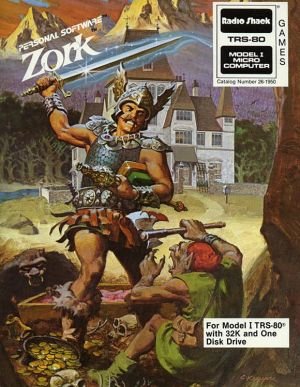 |
The team then approached Personal Software (1978-1984), which at the time was famous for the Apple II spreadsheet program VisiCalc, who agreed to publish the game. In 1980 the first commercial version of Zork was released. It began to sell reasonably well under the Personal Software label, although the Infocom team was not particularly thrilled with the archetypical fantasy cover the publisher created for the game box. The cover featured a muscle-bound warrior swinging a sword at a troll (in the background, rather anachronistically, stands the game’s iconic white house.) Lebling mentioned that nowhere in Zork was your character ever described and this new image “didn’t do it for us.”
VisiCalc and their business platforms quickly became Personal Software’s main focus (strangely enough, Infocom would repeat Personal Software’s mistake a few years later by focusing on their own business application, Cornerstone, instead of the more lucrative, if less “serious,” games that were selling so well) and were not interested in publishing Zork II. By that time Infocom was ready to be a publisher as well and released the sequel themselves in 1981 with a box cover that featured the dungeon brick logo and open, foreboding door that is now so closely associated with the series. The third and final episode of the trilogy, Zork III, would be released in 1982.
As the team continued to adapt the original mainframe Zork to smaller home releases, they were “learning how to write adventure games,” and began to explore new concepts for the two sequels. Lebling talked about the concepts that he believed Infocom got right in the first adventure, from the creation of the new ZIL language to the size of the game. He also talked about what they knew they would need to improve upon, such as the game’s extremely challenging difficulty level (“we killed you altogether way too much”) to the complete absence of any cohesive narrative.
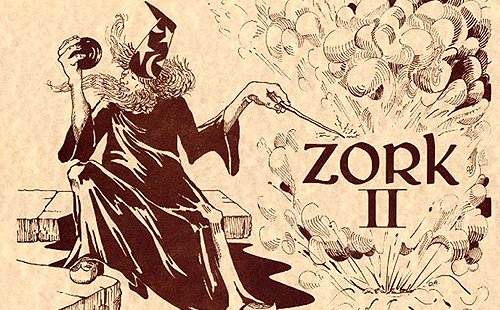 |
Player reference document for Zork II: The Wizard of Frobozz [click for full image] |
“Zork II was, in theory, everything else left over from Zork,” Lebling said. “Zork I was totally just a dungeon crawl. We thought ‘Let’s do something a little bit more interesting.’ There was this character (in Zork II) called the ‘Wizard of Frobozz’. The goal of the game became, not to collect all the treasures, but to find a way to stop him from annoying you, and in some cases kill you, and how you could get rid of him.”
Lebling pointed out two puzzles in the second game that showed how Infocom’s Implementors were becoming more ambitious in their gameplay design. He created a “diamond maze” puzzle for Zork II whose solution required a knowledge of the rules of baseball that Lebling soon realized even most Americans didn't possess, and which was almost completely impenetrable for Infocom’s European audience.
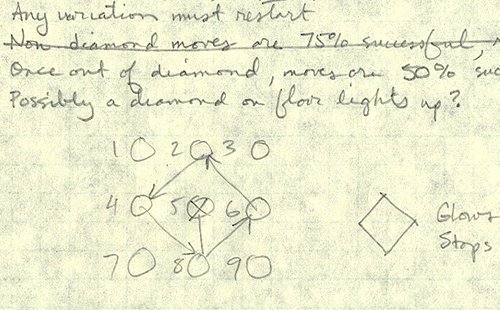 |
Lebling's notes for the 'diamond maze' puzzle [click for full image] |
Blank’s experimentations led him to create the “Bank of Zork” puzzle whose obtuse solution required the player to approach the conundrum from a completely new perspective. “We were trying to come up with a different type of puzzle than find the key to the door,” Blank said. “For the Bank of Zork, the key was that the puzzle was the way you moved through the rooms… I was trying to come up with a puzzle that, in order to figure it out, it wasn’t so much what you were carrying or what you were doing, but how you would move through things which would affect what happened when you went through the shimmering wall.” In fact, even after Lebling solved the Bank of Zork puzzle himself, he was unable to explain how he had finally understood its solution. “No one, not even Marc, has ever successfully explained how it worked,” Lebling said. “But it was a fun puzzle.”
After Zork II was released, Infocom established their first permanent office headquarters at 55 Wheeler Street in Cambridge, Massachusetts. This would be the site where so many more of Infocom’s legendary titles would be designed and written – from Steve Meretzky’s Planetfall series and his collaboration with Douglas Adams on the IF version of The Hitchhiker’s Guide to the Galaxy to Brian Moriarty’s literary Trinity. Wheeler Street provided the perfect location for a unique team at just the right time. By bringing Infocom to one central location, it became much easier for the team to trade ideas and provide instant feedback to each other. “Wheeler Street brought people together,” Lebling said.
 |
55 Wheeler Street, Cambridge, Massachusetts |
For the third and final game in the original Zork trilogy, the team decided to push the narrative envelope even further. For the first time, a Zork game required character growth, as the playable avatar travelling through the adventure had to display the ability to evolve. (As an aside to game historians, this feature would predate a similar system in Richard Garriott’s Ultima IV by three years.) It also introduced one of gaming’s most unusual characters, the powerful and omniscient Dungeon Master of Zork.
“It (Zork III) was more about how you exhibit the characteristics that make you not only a good person but, in the end, a fitting replacement for the Dungeon Master. Instead of a true antagonist like the Wizard of Frobozz in Zork II, you were facing the Dungeon Master of this world,” Lebling explained. “The guy who is, in theory, running the Great Underground Empire, and is really responsible for all the bad things that have happened to you… By the end of Zork III, you should be fit to replace him. It’s not about killing things, it’s about cooperation, it’s about trusting people, it’s about doing the things that make you a better person instead of a better Conan the Barbarian.”
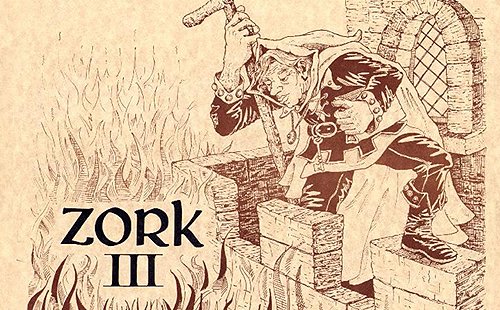 |
Player reference document for Zork III: The Dungeon Master [click for full image] |
The third game also featured a number of gameplay innovations, including the first time travel puzzle in an adventure, a more complex narrative progression, and even a streamlined new scoring system. Infocom’s competitors would often boast about the number of points a player could score in their adventures. Zork III consciously eschewed this scoring arms race by making the final, winning score a mere 9 points. Lebling’s biggest criticism of the final entry was that it was simply too small and left many players wanting more.
 |
Zork packaging, November 1981
|
During this time, Zork I was quickly becoming an enormous success – it would be the top selling computer title every year from 1980-1984, eventually selling 378,987 copies.
Because of the success of the initial Zork trilogy, the game world and its fantastical elements would continue on through Infocom’s Enchanter trilogy. Blank and Lebling would design the eponymously-titled first game in that series and Lebling was the lone Implementor on the final one, Spellbreaker, which he considers the most difficult Infocom game he ever worked on.
In addition to a character receiving a vision in Zork III of an event which would take place in Enchanter, it was also possible to actually meet Zork’s original adventurer during this second trilogy. Of course, Infocom would revisit the world again through Beyond Zork (1987) and in a prequel, Zork Zero (1989). Even Activision, which acquired Infocom in 1986, would release three graphic adventures based on the brand, but this was after Infocom’s original Implementors had long since departed the company.
After concluding his presentation, Lebling invited questions from the audience, answering queries about what it’s like creating compelling narratives in games (“it’s hard”) and where all the humor in Infocom games had come from (“we were just all wise-asses”) before concluding the post-mortem.
More than 30 years after the original Zork was published, a vibrant community for interactive fiction (including Graham Nelson, who created an entirely new IF coding language for a new generation of writers by reverse engineering Infocom’s Z-Machine language), continues to thrive online. The Interactive Fiction Database still dutifully records every new text adventure, and several annual competitions encourage new dungeon masters to create entirely new worlds and puzzles.
 |
Ideas for Zork II: The Wizard of Frobozz |
Despite the name of the presentation, it’s hard to believe that the Zork legacy is something that did, or ever will, really die. The size and passion of the crowd at GDC showed that the love for Zork and all of Infocom’s work is much more than mere nostalgia, but is rather a true appreciation of the wizardry of the original Implementors and the compelling, eternal worlds they created through the written word and our own eager imaginations.
Note: This article has been updated to correctly identify the lab where the PDP-10s were located.




